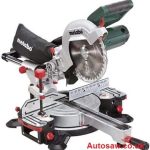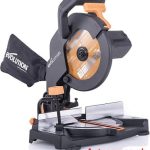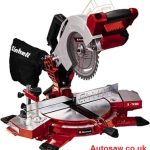As an Amazon Associate, I earn from qualifying purchases.

When it comes to woodworking, having the right tools is essential to ensure precision, efficiency, and the best possible results. Two commonly used power tools in woodworking are the table saw and the miter saw. While both tools serve distinct purposes, choosing between them can be a challenging decision for beginners and even experienced woodworkers. In this article, we will delve into the characteristics, applications, and advantages of each tool, helping you make an informed choice based on your specific woodworking needs.
Contents
Understanding The Table Saw

What is a Table Saw?
A table saw is a powerful woodworking tool consisting of a circular blade mounted on an arbor that is driven by an electric motor. It is designed to make precise cuts on various types of wood, providing stability and accuracy. The blade protrudes through the surface of a flat table, allowing the user to guide the workpiece through the blade.
Components of a Table Saw
A typical table saw consists of several key components:
- Tabletop: The flat surface that supports the workpiece during cutting.
- Blade: The circular cutting tool that determines the type and quality of the cut.
- Fence: A guide parallel to the blade, ensuring straight cuts.
- Miter Gauge: A device used for making angled or crosscuts.
- Riving Knife: A safety feature that prevents kickback.
- Motor: Provides the power to rotate the blade.
Types of Table Saws
Table saws come in various types, including:
- Contractor Table Saw: Portable and suitable for on-site work.
- Cabinet Table Saw: Heavy-duty and designed for professional use.
- Hybrid Table Saw: Combines features of contractor and cabinet table saws.
- Benchtop Table Saw: Compact and lightweight, ideal for small workshops or hobbyists.
Exploring The Miter Saw
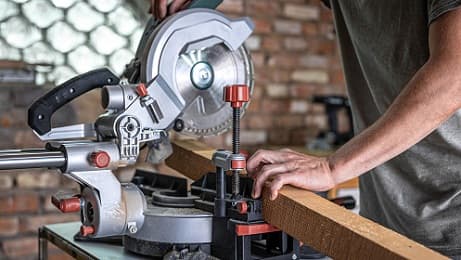
What is a Miter Saw?
A miter saw, also known as a chop saw, is a specialized power tool used for making accurate crosscuts and miter cuts at various angles. It consists of a circular blade mounted on a swing arm that pivots left and right. Miter saws are particularly useful for cutting moldings, framing, and other angled cuts.
Components of a Miter Saw
Key components of a miter saw include:
- Blade: Similar to a table saw, the blade determines the type of cut.
- Base: Provides stability and support for the workpiece.
- Fence: A vertical guide that ensures straight cuts.
- Miter Index: A rotating scale used to set precise angles.
- Bevel Adjustment: Allows the blade to tilt for bevel cuts.
Types of Miter Saws
Miter saws are available in different variations, such as:
- Compound Miter Saw: Allows both miter and bevel cuts simultaneously.
- Sliding Compound Miter Saw: Includes a sliding feature for increased cutting capacity.
- Dual-Bevel Compound Miter Saw: Enables bevel cuts in both left and right directions.
Applications Of Table Saws
Table saws offer a wide range of applications, including:
Rip Cuts
A table saw excels at making long, straight cuts parallel to the wood grain. This is particularly useful for ripping large sheets of plywood or cutting boards to a desired width.
Crosscuts
While crosscutting can be done on a table saw, it requires a miter gauge or a crosscut sled accessory. Crosscuts are used to cut boards to a specific length or create joinery cuts.
Dado Cuts
Table saws equipped with dado blade sets can create grooves and dado cuts used for joinery or accommodating shelves in furniture.
Bevel Cuts
Certain table saw models allow the blade to tilt, enabling bevel cuts for creating angled edges or joints.
Applications Of Miter Saws
Miter saws are highly versatile and find utility in various woodworking tasks, including:
Crosscuts and Miter Cuts
Miter saws excel at making accurate crosscuts and angled miter cuts, making them ideal for cutting moldings, picture frames, and other projects that require precise angles.
Bevel Cuts
With bevel adjustments, miter saws can make bevel cuts for creating angled edges or joints, similar to a table saw.
Compound Cuts
Compound miter saws allow the user to make both miter and bevel cuts simultaneously, providing greater flexibility for complex woodworking projects.
Crown Molding Cuts
Miter saws equipped with appropriate accessories are perfect for cutting crown molding, ensuring accurate and tight-fitting joints.
Comparing Accuracy And Precision
When it comes to accuracy and precision, both table saws and miter saws have their advantages. Table saws offer excellent control for rip cuts and precise measurements with the help of a fence. On the other hand, miter saws provide exceptional accuracy for crosscuts and angled cuts due to their fixed arm and rotating miter index.
Factors To Consider In Choosing The Right Tool
To determine the ideal tool for your woodworking needs, consider the following factors:
Project Requirements
Evaluate the specific woodworking projects you undertake most frequently. Determine whether you need a tool primarily for ripping, crosscutting, or making angled cuts.
Space And Portability
Consider the available space in your workshop or work area. If mobility is essential, a portable table saw or a lightweight miter saw might be a better choice.
Budget
Set a budget that aligns with your woodworking requirements. Remember to consider additional accessories, such as blades and guides, which can affect the overall cost.
Safety Features
Prioritize safety when selecting a saw. Look for features like blade guards, anti-kickback mechanisms, and emergency stop switches.
Pros And Cons Of Table Saws
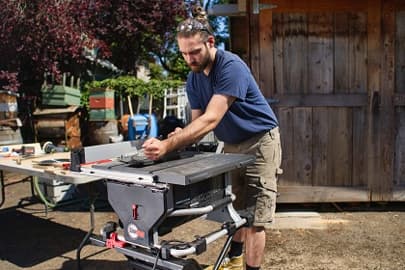
Table saws offer several advantages and disadvantages:
Pros:
- Excellent for rip cuts and precise measurements.
- Suitable for large stock and sheet goods.
- Can accommodate dado blades for joinery work.
Cons:
- Limited for crosscuts and angled cuts without additional accessories.
- Requires more space due to the size of the table.
- Not as portable as miter saws.
Pros And Cons Of Miter Saws
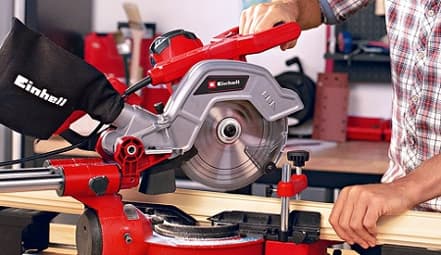
Miter saws also have their own set of advantages and disadvantages:
Pros:
- Ideal for accurate crosscuts and miter cuts.
- Provides versatility for angled cuts and bevel cuts.
- Compact and portable, suitable for smaller workspaces.
Cons:
- Limited capacity for ripping or handling large sheets of material.
- Less suitable for long, straight cuts.
- Additional accessories may be required for certain applications.
FAQs
Can I use a table saw for miter cuts?
Yes, you can make miter cuts on a table saw by using a miter gauge or a crosscut sled. However, miter saws are specifically designed for such cuts and provide better accuracy and ease of use.
Is a miter saw suitable for ripping lumber?
No, a miter saw is not designed for ripping lumber. Table saws are better suited for ripping tasks as they offer more control and stability for long, straight cuts.
Which tool is safer to use, a table saw, or a miter saw?
Both table saws and miter saws can be safe to use when proper safety precautions are taken. However, table saws are known to be more dangerous due to the exposed blade and potential kickback incidents. It is crucial to follow safety guidelines and use appropriate safety features when operating any power tool.
Can I use a miter saw to cut metal?
While miter saws are primarily designed for cutting wood, there are specialized blades available for cutting non-ferrous metals like aluminum. However, it is important to ensure that the miter saw you have is compatible with metal-cutting blades and follow proper safety procedures.
Can I achieve bevel cuts with a table saw?
Certain table saw models come with a tilting arbor that allows you to make bevel cuts. However, miter saws are generally more convenient and accurate for making bevel cuts, especially for angled joinery and precise miters.
Conclusion
In summary, both table saws and miter saws serve specific purposes in woodworking, and choosing the right tool depends on your project requirements, space limitations, and budget. Table saws excel at rip cuts and offer more versatility with the use of accessories, while miter saws provide exceptional accuracy for crosscuts and angled cuts. Consider the pros and cons of each tool, and prioritize safety in your decision-making process.
For professional woodworkers or those involved in extensive woodworking projects, having both a table saw and a miter saw in your workshop can provide the best of both worlds, allowing you to tackle a wide range of tasks with precision and efficiency.
